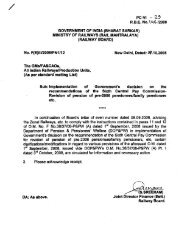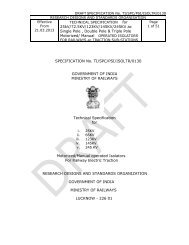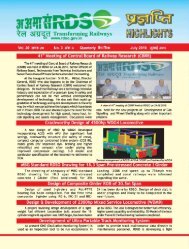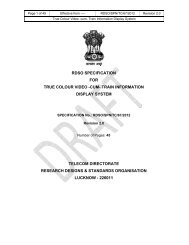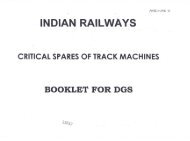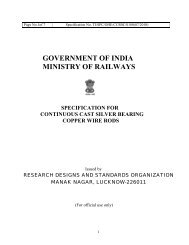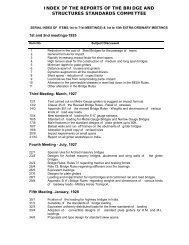ASSESSMENT OF RESIDUAL LIFE OF GIRDERS OF BRIDGE No
ASSESSMENT OF RESIDUAL LIFE OF GIRDERS OF BRIDGE No
ASSESSMENT OF RESIDUAL LIFE OF GIRDERS OF BRIDGE No
You also want an ePaper? Increase the reach of your titles
YUMPU automatically turns print PDFs into web optimized ePapers that Google loves.
11x 48.5 m spans in bridge <strong>No</strong>. 75 were constructed and open to traffic in<br />
the year 1993 and since than the bridges of steel plate girders have been<br />
abandoned.<br />
4.0 METHODOLOGY:<br />
For assessment of residual life of the girders of the bridges, the procedure<br />
as given in BS – 5400 part – 10 , code of practice for fatigue has been<br />
followed. The procedure given in clause 9.0 of the above code for railway<br />
bridges has been used. Two methods for fatigue assessment of railway<br />
bridges are given in clause 9.2 & 9.3 of the code. In method –1,<br />
assessment is done without damage calculation and in method –2,<br />
damage is calculated by using Miner’s summation rule. Both these<br />
methods have been used for the assessment of residual life.<br />
4.1 Method – 1: Fatigue life assessment without damage calculations:<br />
4.1.1 General:<br />
BS-5400 part 10 is a comprehensive code which is based on the concept<br />
of cumulative fatigue damage. The fatigue assessment is based on<br />
Palmgren-Miner’s damage summation model. For fatigue assessment of<br />
railway bridges, the methodology for determination of stress range has<br />
been described for different type of connections and a simplified<br />
procedure has been given for determining the limiting value of the<br />
maximum range of stress for the specified design life for two different<br />
types of standard loadings. Details of RU loading ( Ref; Table- 1) has<br />
been used for calculating the remaining fatigue life, as it is more severe<br />
than IRS MBG loading. As per code, RU loading allows for all<br />
combinations of vehicles currently running or projected to run on railways<br />
in the Continent of Europe, including the United Kingdom and is to be<br />
adopted for the design of bridges carrying main line railways of 1.4 m<br />
gauge and above. The nominal type RU loading consists of four 250 KN<br />
concentrated loads preceded and followed by a uniformly distributed load<br />
of 80 KN/m The code specifies different factor k1, k2, k3, k4 & k5 for design<br />
parameters such as design life, multiple cycle of stress loading, type of<br />
standard loading, annual GMT and multiple lane loading respectively.<br />
The code gives specific methodology and tables to calculate the factors<br />
for different design parameters.<br />
4.1.2 Limiting Stress Range, σT<br />
The constant amplitude non-propagating stress range, σ0 for the<br />
constructional detail is chosen appropriately on the basis of Table – 17 &<br />
Table 8 of the code. The limiting stress range σT is calculated for RU<br />
loading as under:<br />
5



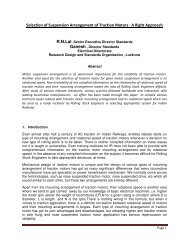

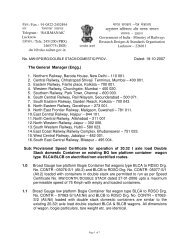
![Hkkjrljdkj] jsy ea= ky; vuql a/ kkuvfHkdYivkSj ekudlax Bu y ... - rdso](https://img.yumpu.com/21978459/1/184x260/hkkjrljdkj-jsy-ea-ky-vuql-a-kkuvfhkdyivksj-ekudlax-bu-y-rdso.jpg?quality=85)

